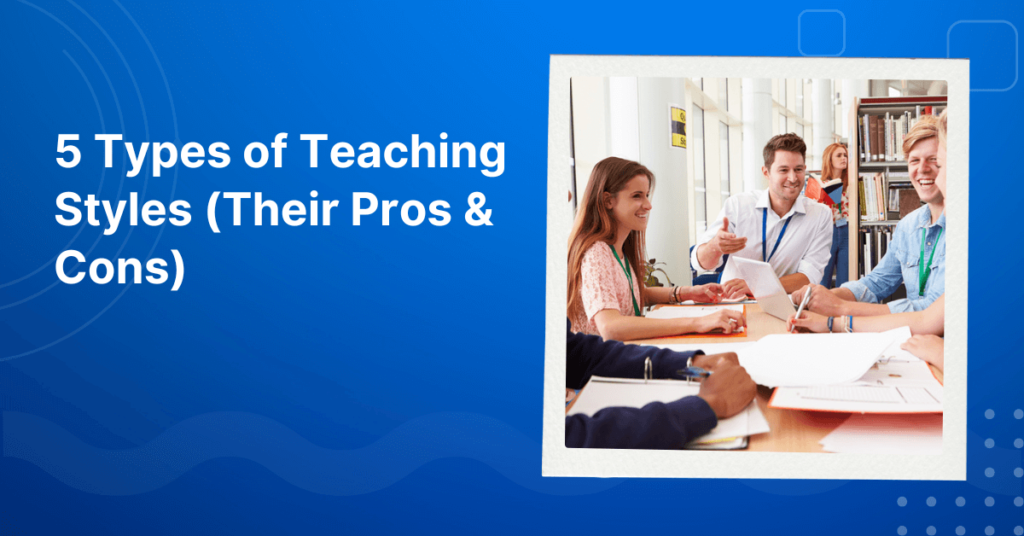Are you curious about the different ways educators approach teaching and how they impact the learning experience? In this article, VTJ‘ll delve into the fascinating world of different teaching styles. Each style comes with its own set of advantages and disadvantages, shaping the way students engage with the material and absorb knowledge. Whether you’re an educator looking to enhance your teaching methods or a student interested in understanding how different styles influence your learning, this exploration will shed light on the pros and cons of each teaching approach. Let’s explore the diverse world of teaching styles and their impact on education.

5 Common Types of Teaching Styles
When it comes to education, teachers play a crucial role in shaping the learning experiences of their students. One of the key factors that significantly influences the classroom environment is the teaching style employed by educators. In this article, we will delve into five common types of teaching styles and discuss their respective pros and cons. 5 common types of teaching styles including:
- The Authority, or lecture style
- The Demonstrator, or coach style
- The Facilitator, or activity style
- The Delegator, or group style
- The Hybrid, or blended style
Explore More Teaching Tips: Why Students Get Bored & How to Engage Bored Students in the Class
Read more: 22+ SMART Teacher Goals Examples in 2025
The Authority, or lecture style

The Authority teaching style is characterized by a teacher-centered approach, where the instructor takes on the role of the primary knowledge provider. In this method, information is delivered through lectures, and students are expected to absorb the material presented.
Pros:
- Clear structure: the authority style provides a structured and organized learning environment.
- Efficient content delivery: concepts can be covered comprehensively within a short period.
- Discipline: this approach establishes a disciplined classroom atmosphere.
Cons:
- Limited student engagement: minimal interaction can lead to reduced student engagement.
- Passive learning: students may become passive recipients of information without actively participating.
- Learning differences: it may not cater to individual learning preferences and abilities.
Discover Related Guides: Guide on How to Teach Vocabulary Effectively for Teachers
Read more: What is blended learning? Types, Examples & Benefits?
The Demonstrator, or coach style

The Demonstrator teaching style is akin to a coaching or mentoring role, where the teacher actively demonstrates concepts and encourages student involvement through hands-on activities.
Pros:
- Active learning: students engage in practical tasks, promoting better retention and understanding.
- Real-world applications: demonstrations make it easier for students to see how concepts relate to the real world.
- Encourages critical thinking: this style fosters problem-solving and independent thinking skills.
Cons:
- Time-consuming: preparing and conducting demonstrations can be time-intensive.
- Resource requirements: it may demand specific resources and materials for effective demonstrations.
- Inclusivity challenges: some students might find it challenging to keep up with the pace of demonstrations.
Continue Learning: 120+ High and Middle School Debate Topics for Students
Read more: How To Write a Curriculum in 8 Steps: A Complete Guide
The Facilitator, or activity style

The Facilitator teaching style centers around guiding students through collaborative activities and discussions. Here, the teacher acts as a facilitator, supporting students as they explore and construct their knowledge.
Pros:
- Active participation: students actively participate in their learning process, enhancing their understanding.
- Social skills development: collaborative activities promote teamwork and communication skills.
- Personalized learning: students can pursue topics that interest them within a structured framework.
Cons:
- Classroom management: it requires efficient management of group dynamics and discussions.
- Time constraints: covering a wide range of topics may become challenging within limited time frames.
- Potential for misinformation: students might grasp incorrect information if not guided effectively.
See More Strategies: 4 Types of Learning Styles: How to Use VARK Model in Teaching
Read more: How To Write a Lesson Plan in 6 Steps: The Complete Guide
The Delegator, or group style

The Delegator teaching style involves dividing the class into groups and assigning them specific tasks or projects to work on independently.
Pros:
- Promotes teamwork: students learn to work together and value teamwork.
- Develops leadership skills: group activities provide opportunities for students to take on leadership roles.
- Encourages responsibility: students take ownership of their tasks and outcomes.
Cons:
- Uneven participation: some group members may contribute more than others, leading to imbalanced learning experiences.
- Conflict resolution: it may be necessary to address and resolve conflicts that arise within groups.
- Individual assessment challenges: evaluating individual contributions can be complex during group tasks.
Explore More: 14 Types of teaching methods for an effective lesson
Read more: 20+ Effective Classroom Management Strategies and Techniques
The Hybrid, or blended style

The Hybrid teaching style combines elements of different teaching approaches to create a flexible and adaptive learning environment. It incorporates both teacher-led instruction and student-centered activities.
Pros:
- Versatility: the hybrid style allows teachers to tailor their approach based on content and student needs.
- Technological integration: it makes use of various educational technologies to enhance learning experiences.
- Balanced learning: students receive a blend of direct instruction and active engagement.
Cons:
- Planning complexity: designing a coherent hybrid curriculum may require careful planning and organization.
- Technology dependence: technical issues can disrupt the flow of the class.
- Training requirements: educators may need training to effectively implement hybrid teaching methods.
Read more: Practical Tips to Deal with Negative Teacher
Discover Your Preferred Teaching Style
As an educator, understanding and adopting the most suitable teaching style can significantly impact the success of your students’ learning journey. While each teaching style has its strengths and weaknesses, there is no one-size-fits-all approach. Experimenting with different styles and reflecting on their effectiveness can help you discover your preferred method for engaging your students.
Read more: What is TPR (Total Physical Response)? How can I use it?
Read more: 15+ Ways to build confidence in your ESL students
As you embark on your teaching journey, always remember that your passion for education and your commitment to the growth of your students will be the guiding light in shaping your teaching style. Hopefully, through the suggestions from VTJ, you can find effective teaching styles for yourself
FAQs
Is one style of teaching better than others?
=> No, there is no definitive answer to which teaching style is the best. The effectiveness of a teaching style depends on various factors, including the subject matter, student demographics, and individual learning preferences.
How to adapt teaching styles to different learning styles?
=> Adapting teaching styles to different learning styles involves understanding your students’ preferences, strengths, and challenges. Employ a diverse range of instructional methods, such as visual, auditory, and kinesthetic approaches, to cater to various learning modalities.
Does classroom diversity influence my style of teaching?
=> Yes, classroom diversity can influence your teaching styles. Being sensitive to the cultural, linguistic, and learning diversity within your classroom can help you create an inclusive and supportive learning environment for all students.






